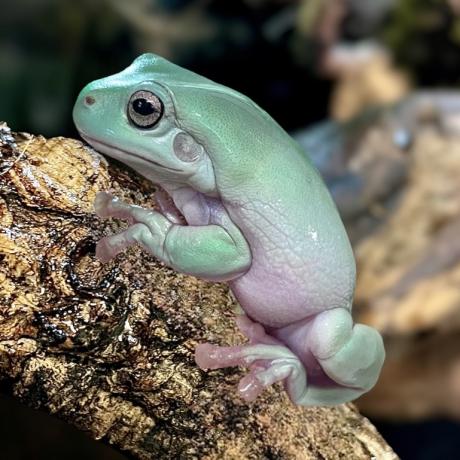

The is the best tree frog to keep if you are a beginner or wanting a new species to add to your collection. With their round, plump bodies and big appetites, these will keep you amused.
This very popular Tree Frog grows to 10cm (4 inches) with males being slightly smaller. Their skin looks slimy, however this is waxy to touch. Most people call them "White Tree Frogs" instead of "White's Tree Frogs" - this refers to the name of the man who described them. Despite their name, these frogs range in colour from green, turquoise to brown, most will change colour slightly.
They have big toes, which help them climb up plants and branches and have a fold of skin from their eye to the front legs. This skin makes them look very fat and plump, but in a way, very cute.
They are found near ponds and forests in Northern and Eastern parts of Australia, they have also been introduced to New Guinea, Indonesia and New Zealand.
A glass tank is ideal, or you could get away with using a large plastic tank if the temperature and humidity levels are correct for younger frogs. Use either a soil substrate or bark chippings and provide branches, logs and sturdy plants for them to hide between.
They like a daytime temperature of 22 - 26C with a drop to about 20C at night. If you use a small bulb for heat, you must make sure that the frogs cannot leap against this as burns will cause injury to your frog. Alternatively, you can use a heat mat, placed on the side of the tank. Keep the humidity around 70-80%, this can be maintained with spraying treated water lightly each day.
Feed them a varied diet of insects such as crickets, locusts, butterworms, phoenix worms, silkworms and roaches. They enjoy earthworms and the odd defrost pinkie (you need to move this as if it is alive). You must take care that they do not become too fat from over feeding!
Caution: When providing water for your amphibians, this MUST be treated with an Aquarium de-chlorinated solution. The Chlorine will harm and possible kill your amphibians after a period of time. Alternatively, you can use fresh, clean rainwater or leave a bucket of tap water for 24hr and this will be safe to use.